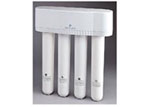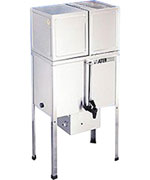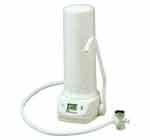While lead has many useful industrial applications, in water lead is a toxic metal, and can cause serious cumulative damage to the brain, organs and blood cells over time. Lead occurs naturally in ground waters through out the world, but most contamination of lead in drinking water comes from lead leaching from service pipes, fixtures, valves and other materials containing lead. The United States Environmental Protection Agency (USEPA) estimates that approximately 20 percent of human exposure to lead is attributable to lead in drinking water.
Lead is commonly used in household plumbing materials and water service lines. The greatest exposure to lead is swallowing or breathing in lead paint chips and dust.
Lead in drinking water can cause a variety of serious health effects. In babies and children, exposure to lead in drinking water can result in delays in physical and mental development, along with slight deficits in attention span and learning abilities. In adults, it can cause increases in blood pressure. Adults who drink this water over many years can develop kidney problems or high blood pressure.
Lead is rarely found in source water, but enters tap water through corrosion of plumbing materials. Homes built before 1986 are more likely to have lead pipes, fixtures and solder. However, new homes are also at risk: even legally "lead-free" plumbing may contain up to 8 percent lead. The most common problem is with brass or chrome-plated brass faucets and fixtures which can leach significant amounts of lead into the water, especially hot water and instant hots unless they use lead-free fixtures.
Lead is strictly regulated in public water supplies, and the USEPA sets a maximum allowable level of 15 parts per billion, or .015 milligrams per liter. Generally, water that is first drawn, after sitting for several hours in piping that contains lead, is much higher in lead, than after the pipes have been flushed. For this reason, when one is testing for lead, the water should be allowed to sit in the pipes over night, so a first draw, or worst case scenario can be determined.
Often lead problems can be corrected by replacing the lead service pipes with new piping, by replacing lead-leaching brass fixtures with new non-leaded brass, and/or by treating for corrosive water conditions to prevent the water from leaching lead from the piping or fixtures.
For lead removal in drinking water, our NSF certified reverse osmosis systems, NSF certified carbon block filters, and distillers work well for one tap or faucet, referred to as point-of-use.
For whole house treatment, or for small communities with lead in ground water, we offer custom systems for specific applications. Typically these systems employ a special metal oxide media designed for lead removal. Pretreatment and total system design is important. We also offer corrosion control products for correcting corrosive water conditions if the lead is leaching out in the distribution system.
Need help selecting a system? Fill out our quick and easy Water System Designer Form and get a response in 24 hours or less.
Want More Information? Visit USEPA site on lead in drinking water.
Easy do-it-yourself test kits for lead: Lead Test Kits
Do it yourself and laboratory testing for corrosion: Corrosion Test Kits


